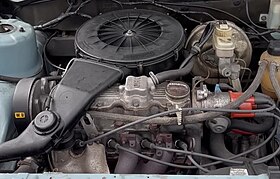
Back Motor GM Family II Catalan GM Family II Italian GM 패밀리 2 엔진 Korean GM Family II Polish GM Family II motoru Turkish
| Family II engine | |
|---|---|
 An early GM Family II engine (16S) fitted to a 1982 Opel Ascona C (Vauxhall Cavalier Mk2) | |
| Overview | |
| Manufacturer | |
| Also called |
|
| Production | |
| Layout | |
| Configuration | |
| Cylinder block material | Cast iron |
| Cylinder head material | Aluminium |
| Valvetrain |
|
| Combustion | |
| Oil system | Wet sump |
| Cooling system | Water-cooled |
| Chronology | |
| Predecessor | |
| Successor |
|
The Family II is a straight-4 piston engine that was originally developed by Opel in the 1970s, debuting in 1981. Available in a wide range of cubic capacities ranging from 1598 to 2405 cc, it simultaneously replaced the Opel CIH and Vauxhall Slant-4 engines, and was GM Europe's core mid-sized powerplant design for much of the 1980s, and provided the basis for the later Ecotec series of engines in the 1990s.
The Family II shares its basic design and architecture with the smaller Family I engine (which covered capacities from 1.0 to 1.6 litres) - and for this reason the Family I and Family II engines are also known informally as the "small block" and "big block", respectively - although the 1.6 L capacity was available in either type depending on its fuelling system.
The engine also spawned two diesel variants, the 1.6 L and 1.7 L.
The engine features a cast iron block, an aluminium head, and a timing belt driven valvetrain. The timing belt also drives the water pump. It was first used in the Opel Kadett D, Ascona C, and their corresponding Vauxhall sister models, the Astra and Cavalier II. Many General Motors subsidiaries, including Daewoo, GM do Brasil, GM Powertrain, and Holden have used this design.
Family II engines for the European and Australasian markets were manufactured by Holden at its Fisherman's Bend plant in Melbourne until 2009, whilst the Americas were supplied from the São José dos Campos plant in the São Paulo region of Brazil.
By 1986, the Family II unit had almost completely replaced the CIH engine as Opel/Vauxhall's core 4-cylinder engine - the CIH continuing only in 2.4L 4-cylinder format, and in all 6-cylinder applications in the Omega and Senator models until 1994.
The development track of these engines split in 1987, with the introduction of the 20XE; which featured a 16-valve DOHC head, with Holden production of the SOHC versions ending in 2009. Although SOHC versions stayed in production in Brazil, most DOHC engines were replaced by the all-aluminium GM Ecotec engine family.
In 2004, a 2.0 L MultiPower engine was made available for the taxi market which could use gasoline, alcohol, and natural gas.
- ^ "Werk Kaiserslautern. Zahlen und Fakten". Retrieved 29 December 2014.
- ^ "Holden stops Family II engine Production". Zer Customs. Retrieved 23 May 2014.
- ^ "GM do Brasil Milestones: 1980 – 1989". Retrieved 29 December 2014.
© MMXXIII Rich X Search. We shall prevail. All rights reserved. Rich X Search